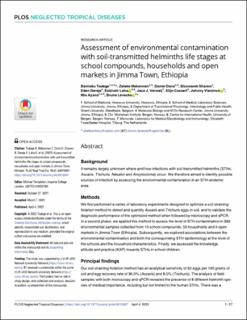Assessment of environmental contamination with soil-transmitted helminths life stages at school compounds, households and open markets in Jimma Town, Ethiopia
Tadege, Bamlaku; Mekonnen, Zeleke; Dana, Daniel; Sharew, Bizuwarek; Dereje, Eden; Loha, Eskindir; Verweij, Jaco J.; Casaert, Stijn; Vlaminck, Johnny; Ayana, Mio; Levecke, Bruno
Journal article, Peer reviewed
Permanent lenke
https://hdl.handle.net/11250/2991387Utgivelsesdato
2022-04-01Metadata
Vis full innførselSamlinger
- Publications [1488]
Originalversjon
in PLoS Neglected Tropical Diseases vol. 16 no. 4 e0010307 pp. 1-27 10.1371/journal.pntd.001030710.1371/journal.pntd.0010307
Sammendrag
Background It remains largely unknown where and how infections with soil-transmitted helminths (STHs; Ascaris , Trichuris , Necator and Ancylostoma ) occur. We therefore aimed to identify possible sources of infection by assessing the environmental contamination in an STH-endemic area.
Methods We first performed a series of laboratory experiments designed to optimize a soil straining-flotation method to detect and quantify Ascaris and Trichuris eggs in soil, and to validate the diagnostic performance of the optimized method when followed by microscopy and qPCR. In a second phase, we applied this method to assess the level of STH contamination in 399 environmental samples collected from 10 school compounds, 50 households and 9 open markets in Jimma Town (Ethiopia). Subsequently, we explored associations between the environmental contamination and both the corresponding STH epidemiology at the level of the schools and the household characteristics. Finally, we assessed the knowledge, attitude and practice (KAP) towards STHs in school children.
Principal findings Our soil straining-flotation method has an analytical sensitivity of 50 eggs per 100 grams of soil and egg recovery rate of 36.0% ( Ascaris ) and 8.0% ( Trichuris ). The analysis of field samples with both microscopy and qPCR revealed the presence of 8 different helminth species of medical importance, including but not limited to the human STHs. There was a significant association between the environmental contamination and prevalence of any STH infections at the school level only. The KAP indicated a lack of knowledge and awareness of STHs.
Conclusions/Significance Our optimized straining-flotation method has a moderate diagnostic performance and revealed that life stages of helminths are ubiquitous in the environment, which might be due to the poor sanitary facilities at both the schools and the
Serie
PLoS Negl Trop Dis . vol. 16 no. 4PLoS Neglected Tropical Diseases vol. 16 no. 4 e0010307
